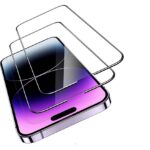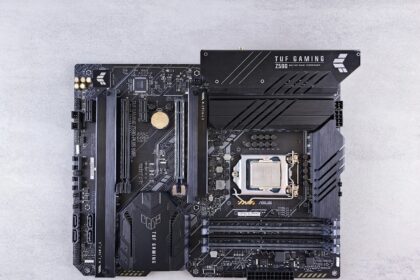Picking the right cable matters more than most people think. Modern GPUs and monitors often include DisplayPort, and choosing the correct version and build keeps your image sharp and your frame rates smooth.
DisplayPort versions like DP1.4 and DP2.0/2.1 offer very different ceilings. DP2.0/2.1 can reach up to 80Gbps, which beats HDMI 2.1’s 48Gbps and helps with high-refresh video and advanced features.
We’ll guide you through compatibility checks and practical choices. Learn when a short, well-shielded copper cable is enough and when fiber or higher-grade construction prevents dropouts at home.
Expect clear tips on length, connector quality, and port matching so you preserve audio and image performance. By the end, you’ll know which displayport cable fits your device and setup without wasting money.
Key takeaways: match version with your display, favor good build quality, and pick the right length for reliable performance.
Quick Buyer’s Guide: Match your display, refresh rate, and length to the right DP cable
Start by checking what your display and GPU actually support. Look at resolution and refresh targets like 4K 120Hz or 8K 60Hz, then pick the generation that meets that bandwidth.
Short runs under ~10m usually work well with copper; longer runs need fiber-optic options. Note that fiber cables are often unidirectional and labeled Source → Display.
- Match monitor specs with DP1.2/1.4 for mainstream 1080p/1440p and many 4K setups; reserve DP2.0/2.1 for high-refresh gaming and pro work.
- Verify ports on both devices—Full-size, Mini, or USB-C Alt Mode—so connections fit first try.
- Pick DP40 (UHBR10, 40Gbps) or DP80 (UHBR20, 80Gbps) based on the bandwidth your video and gaming needs demand.
- Use DP++ adapters only after confirming resolution and refresh support for HDMI displays.
Plan for the near future and avoid overpaying for unused bandwidth. For everyday reliability, favor snug latches, clear labeling, and solid strain relief so your connections last and the viewing experience stays smooth.
DisplayPort bandwidth, versions, and resolutions: what you actually need today
Bandwidth limits define what resolutions and rates your setup can achieve, so read labels carefully.
DP1.2 and DP1.4 still serve most users well. They handle 1080p and 1440p with ease and support many 4K modes. DP1.4 can reach 4K at 120Hz or 8K at 60Hz when paired with DSC and HDR features.
When DP2.0/2.1 matters
Pick DP2.0 or DP2.1 if your goal is extreme gaming or pro video work. These standards raise total throughput up to 80Gbps, enabling high refresh rates and higher resolutions without aggressive compression.
VESA DP40 vs DP80 certification
VESA now certifies DP40 (UHBR10, 40Gbps) and DP80 (UHBR20, 80Gbps) cables. Certification means ATC testing, VESA review, and a licensed logo. That reduces guesswork when buying cables for demanding modes.
- Practical rule: DP1.2/1.4 for mainstream monitors and daily gaming.
- Upgrade path: DP2.0/2.1 and DP80 for 8K, high-refresh 4K, or multi-stream professional setups.
- Compare: DisplayPort offers higher peak throughput than HDMI 2.1’s 48Gbps, which helps with cutting-edge video.
Match your device and monitor capabilities, watch for certification labels, and prioritize real-world support over headline bandwidth numbers. That keeps your video stable and your purchase sensible.
Cable length, AWG, and signal integrity
Gauge and run length shape whether copper will carry your desired resolution and refresh. Thicker conductors like 24AWG lose less energy than 26AWG over the same span, so they preserve transmission and reduce signal degradation.
Copper OFC cables work well for short runs—typically under 10 meters. For longer runs or higher bandwidth video, fiber-optic options with electro-optical conversion handle distances past 100 meters and resist EMI. Note that many fiber units are directional and labeled Source → Display.
Practical tips for real setups
- Pick the shortest workable cable length and avoid excess tight bends.
- Look for braid + foil shielding; braid often covers ~85% while foil gives full coverage.
- Leave modest slack so connectors and conductors don’t bear strain during movement or cleaning.
- Match gauge with planned length: thicker wires for longer runs, fiber when distance or higher bandwidth demands exceed copper’s limits.
These steps help keep signals clean, protect image quality, and make sure your devices reach target resolution and refresh without flicker or dropouts.
Build quality that protects image quality: materials, shielding, and jackets
Well-built connectors and layered shielding protect transmission and preserve visual fidelity. Quality materials stop interference, keep signals steady, and prevent flaky connections during long sessions.
Shielding matters: aluminum foil, braid coverage, and EMI resistance
Foil plus braid is the standard for high-quality cables. Foil gives full coverage while a braided mesh (.about 85% coverage) blocks stray EMI and radio noise.
Outer jackets: PVC vs nylon braiding for durability and wear resistance
PVC jackets offer good protection, but cheap recycled PVC can tear. Nylon braid resists abrasion and looks better when cable runs are visible.
Connectors and pins: gold-plated shells and high-quality tin bronze pins
Gold plating fights corrosion on shells. Tin bronze pins, often nickel-then-gold plated, hold their spring and contact reliability over thousands of insertions.
Manufacturer reliability: testing, equipment, and why certification signals quality
Reputable makers invest in R&D and in-house testing like ATC/VESA checks. Certification and lab tests mean less guesswork on real-world performance.
- Strong shielding reduces EMI so your monitors keep a clean signal path.
- Look for molded strain relief, snug latches, and solid soldering at connectors.
- Visual checks—tight braid, uniform plating, clear logos—help verify build quality before purchase.
| Component | Typical Build | Benefit | Notes |
|---|---|---|---|
| Shielding | 100% foil + ~85% braid | Lower EMI, stable signals | Critical for long runs and noisy environments |
| Jacket | PVC or nylon braid | Durability, abrasion resistance | Nylon preferred for visible routing |
| Connectors | Gold-plated shell, tin bronze pins | Corrosion resistance, reliable contact | Check for firm latch and strain relief |
| Certification | VESA/ATC tested | Assured standards compliance | Look for legit logos and lab reports |
Final tip: prioritize build quality when shopping for displayport cables. Good materials and tested manufacturing translate into steady performance for gaming and professional monitors—make sure your purchase matches the features you need.
How to Choose a DisplayPort Cable for your ports and devices
Confirm the exact port on both devices so adapters and plugs match at first try. This prevents returns and saves time during setup. Check device manuals or the port shape on your laptop, GPU, or dock.
DP vs Mini DP vs Thunderbolt
DP and Mini DP are distinct physical interfaces. Thunderbolt often uses the Mini DP form but offers extra features. That means a Mini-shaped plug may not provide Thunderbolt functions.
| Interface | Physical cue | Notes |
|---|---|---|
| Full-size DP | Wide rectangular | Standard monitors and GPUs |
| Mini DP | Smaller trapezoid | Older laptops and some docks |
DP++ dual mode: HDMI and DVI adapters
DP++ lets passive adapters output HDMI or DVI. Use them when the monitor only accepts HDMI/DVI, but confirm support for your target resolution and refresh rates.
USB-C to DisplayPort (Alt Mode)
Not every USB-C port supports video. Verify that your device lists DisplayPort Alt Mode or video support before buying. Some USB-C adapters and cables are directional—look for labeling like Source → Display.
- Identify port types on devices and monitors before ordering parts.
- Use active adapters when passive ones cannot meet bandwidth or conversion needs.
- Update firmware and use certified cables for high refresh rate setups (for example, 4K 144Hz).
Optimizing performance: refresh rates, DSC, HDR, and firmware
Getting stable high-refresh performance means aligning version limits, compression options, and current device firmware. Match your target like 4K 120Hz, 8K 60Hz, or 144Hz gaming with the port, certified cable, and GPU output. This prevents mode drops and odd frame pacing.
Matching resolution and refresh targets
Confirm the monitor’s supported resolutions and refresh rates before changing settings. DP1.4 often runs 4K at 120Hz or 8K at 60Hz when DSC is active. DP2.0/2.1 gives extra headroom for very high refresh modes.
Display Stream Compression and HDR
Enable DSC in GPU or display menus when you push beyond raw link bandwidth. Turn on HDR for richer color, but verify both ends support HDR formats. Compression plus HDR unlocks higher-rate video without major image loss.
Firmware and practical setup tips
Keep laptops, monitors, and docks updated. Firmware fixes often resolve random black screens and unstable transmission. Use certified USB-C Alt Mode adapters when the port advertises video support.
- Match targets: align resolution and refresh with the correct version and certified cable.
- Adjust settings: reduce chroma or bit depth if needed to reach a preferred refresh without visible trade-offs.
- Troubleshoot quickly: check ports, swap a known-good cable, and confirm in-menu options like DSC and HDR.
| Task | Quick action | Why it matters |
|---|---|---|
| Enable DSC | GPU/display menu | Raises effective bandwidth for high-rate video |
| Update firmware | Manufacturer site or utility | Fixes compatibility and transmission bugs |
| Use certified parts | Verified logos and reviews | Maintains signal integrity at demanding rates |
Connector and cable features that enhance everyday experience
Small connector details make a big difference in everyday setups. Good features improve reliability and save time when swapping monitors or moving a desk. Simple choices reduce stress and keep video flowing without surprises.
Locking latches and snug fits for stable connections
Prefer locking-latch connectors for a firm click-in that resists accidental unplugging. This is especially useful for gaming or standing-desk rigs where movement is common.
Low-profile plugs help when space is tight behind monitors. They lessen torque on the port and increase long-term compatibility with thin bezels.
Cable management essentials: right length and smart routing
Pick length that avoids excess loops but leaves modest slack near the port. Slack reduces strain on pins and stops internal wire fatigue.
- Jacket and strain relief: nylon-braided jackets resist abrasion while staying flexible for daily use.
- Labeling: mark ends so anyone in your office can reconnect devices quickly.
- Fiber warning: fiber options are often directional—follow the Source → Display label for correct video flow.
| Feature | Benefit | When it matters |
|---|---|---|
| Locking latch | Stable connections | Gaming, moving desks |
| Nylon jacket | Durability + flexibility | Visible runs, daily handling |
| Low-profile plug | Less port stress | Tight spaces behind monitors |
Small touches like Velcro ties, labeled ends, and under-desk trays lift the day-to-day experience. They improve airflow, preserve port quality, and make setups easier for everyone.
Conclusion
Finish by aligning targets and hardware so your video and gaming sessions stay stable and sharp.
Match your target resolution and refresh rate with the correct DP generation and a certified displayport cable. Make sure your ports and devices support that standard before you buy.
Keep runs short when possible; use copper for home setups and consider fiber for long distances or EMI-heavy environments. Favor multilayer shielding, sturdy jackets, and proven connector materials for reliable performance and better image quality.
Tip: weigh DP40 versus DP80 certification and avoid overpaying for bandwidth your displays won’t use. Use DP++ adapters when HDMI compatibility is needed, and keep firmware, HDR, and DSC settings current for best results.
FAQ
What bandwidth do I need for 4K at 120Hz?
For 4K at 120Hz you’ll want at least DP1.4 with Display Stream Compression (DSC) or DP2.0 without compression. DP1.4 with DSC can handle 4K120 on many monitors; DP2.0 gives extra headroom for HDR and uncompressed signals.
Can a long copper cable support high refresh rates and resolutions?
Copper works well for short runs under 3 meters at high bandwidths. For longer runs, signal loss grows and you may need thicker AWG, an active copper cable, or a fiber-optic option to preserve high refresh rates and image quality.
How does AWG affect signal transmission?
Lower AWG numbers mean thicker conductors and lower resistance. A 24AWG cable will carry high-bandwidth signals farther than 26AWG before degrading, so choose thicker wires for longer or demanding setups.
Is DP1.2 still useful for modern displays?
Yes. DP1.2 reliably supports 1080p at high refresh rates and 4K at 60Hz. It remains a budget-friendly choice when you don’t need 4K120 or 8K performance.
What’s the difference between UHBR10 and UHBR20 certification?
UHBR10 (40Gbps) and UHBR20 (80Gbps) are VESA classifications for maximum throughput. UHBR20 supports higher resolutions and refresh rates—useful for 8K or aggressive multi-monitor gaming—while UHBR10 suits most 4K high-refresh setups.
Do I need gold-plated connectors or special shielding?
Gold plating resists corrosion and helps long-term reliability. Good shielding—foil plus braid—reduces EMI and keeps image quality stable, especially near wireless gear or power cables.
Can I convert a DP signal to HDMI or DVI easily?
Passive adapters work when the source supports DP++ dual mode, which outputs HDMI/DVI signals. For higher bandwidth or modern HDMI features, use an active adapter or a direct HDMI cable from a compatible port.
How does DSC affect image quality and latency?
DSC is visually lossless compression that lets higher resolutions and refresh rates pass over existing bandwidth. It introduces negligible latency for gaming and looks identical for most content when implemented correctly.
Are USB-C to DisplayPort cables directional?
Many USB-C to DP cables are directional: some carry signal only from USB-C host to DisplayPort monitor. Check product specs and device Alt Mode support before buying to ensure compatibility.
When should I pick fiber-optic over copper?
Choose fiber for runs longer than about 5–7 meters when you need maximum bandwidth with no signal loss. Fiber stays lightweight, avoids EMI, and preserves high refresh rates and resolutions across long distances.
Will firmware updates improve display performance?
Yes. Monitor and GPU firmware updates can add compatibility for features like DSC, HDR tweaks, and improved handshake stability, which helps maintain higher refresh rates and consistent image quality.
Do locking latches and snug connectors matter?
They do. Locking latches prevent accidental disconnects and ensure consistent electrical contact, which reduces flicker and intermittent signal issues in daily use.
How much slack should I leave when routing cables?
Leave gentle slack to avoid tension on connectors and ports. Avoid tight bends and acute angles—these can damage conductors and cause signal degradation over time.
Can a single cable support HDR and high color depth?
Yes, provided the cable and ports support sufficient bandwidth (DP1.4 with DSC or DP2.0). High dynamic range and deep color increase data rates, so verify your cable’s certified throughput to ensure full HDR performance.
Are branded or certified cables worth the extra cost?
Reputable brands and VESA-certified cables often include better testing, materials, and warranty support. For high-refresh gaming or professional color work, certification reduces the risk of compatibility and signal issues.
























